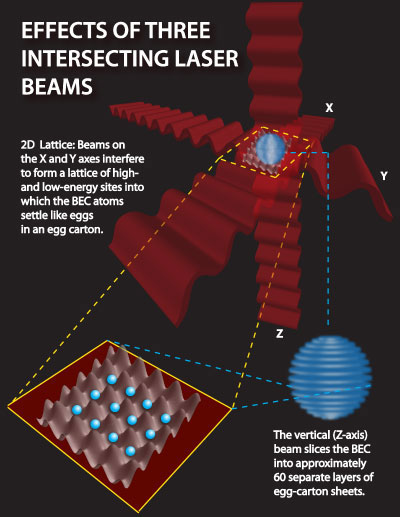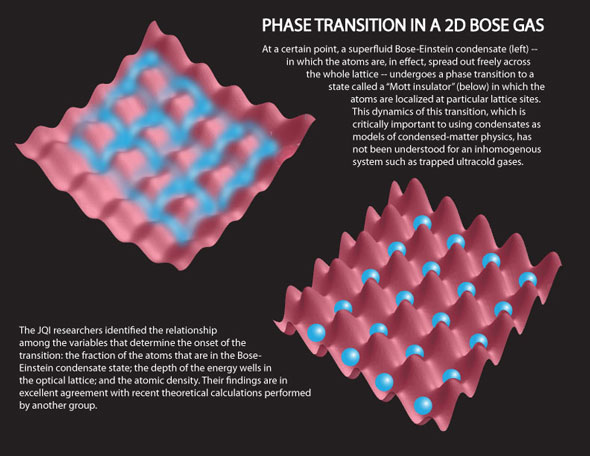| Posted: July 29, 2010 |
Physicists identify the transition from superfluid to Mott insulator |
|
(Nanowerk News) Researchers studying a gas of trapped ultracold atoms have identified a set of conditions, never before observed but in excellent agreement with new theoretical predictions, that determine the onset of a critical "phase transition" in atomic arrays used to model the behavior of condensed-matter systems.
|
|
The findings provide a novel insight into the way collections of atoms suddenly cease to be a superfluid, which flows without resistance, and switch to a very different state called a "Mott insulator." That transition and similar phenomena are of central interest to the science of solid-state materials, including superconductors.
|
|
"This work shows that the transition can be precisely controlled and confirms that it can be described by only two independent variables," says lead researcher Karina Jiménez-García, a member of Ian Spielman's group at the National Institute of Standards and Technology (NIST) and the Joint Quantum Institute (JQI). The group reports its findings in a forthcoming issue of Physical Review Letters ("Phases of a 2D Bose Gas in an Optical Lattice").
|
 |
|
In order to understand the behavior of materials on the atomic and molecular scale, researchers often cannot experiment directly with samples. In many cases, they need model systems – analogous, at microscopic dimensions, to the physical models built by engineers to test the dynamics of a planned structure – that allow them to change one or two experimental parameters at a time while holding the rest constant. That can be prohibitively difficult, if not impossible, in bulk samples of real material.
|
|
But in recent years, quantum science has made it possible to create accurate and highly illuminating models of condensed-matter systems by using ensembles of individual atoms which are confined by electrical and magnetic forces into patterns that mimic the fundamental physics of the repeating structural pattern, or "lattice," of a solid material.
|
|
Improving these quantum-mechanical models is an important research area at JQI, and Spielman's group has been investigating a model for the superfluid-to-Mott insulator (SF-MI) phase transition – the point at which the atoms cease to share the same quantum properties, as if each atom were spread over the entire lattice, and change into a set of individual atoms trapped at specific locations, that do not communicate with one another.
|
|
The group's experimental setup at NIST's Gaithersburg, MD facility uses a cloud of about 200,000 atoms of rubidium that have been cooled to near absolute zero and confined in a combination of magnetic and optical potentials. In those conditions, a majority of the atoms forms a Bose-Einstein condensate (BEC), an exotic condition in which all the atoms coalesce into exactly the same quantum state.
|
|
Then the team loads the BEC – which is about 10 micrometers in diameter, or about one-tenth the width of a human hair – into an "optical lattice" that forms at the intersection of three laser beams placed at right angles to one another [See Figure 1, left], two horizontal and one vertical. Interference patterns in the beams' waves cause regularly spaced areas of higher and lower energy; atoms naturally tend to settle into the lowest-energy locations like eggs in an egg carton.
|
|
The depth of the lattice wells (the cavities in the egg carton) is adjusted by varying the intensity of the laser beams. [See Figure 2, right] In a relatively shallow lattice, atoms can easily "tunnel" from one site to another in the condensate superfluid state, whereas deep lattice wells tend to hold each atom in place, producing the non-condensate insulator state. "We can tune the depth of all the wells in the carton by adjusting the intensity of the laser beams which create it," Jiménez-García explains. "We can go from a flat carton to a carton with very deep wells."
|
|
That general lab arrangement – ultracold trapped atoms suspended in an optical lattice – is the current standard worldwide for experiments on condensed-matter models. But it has a serious problem: The mathematical theory behind the model is predicated on a completely homogenous system, whereas arrays such as the JQI group uses are only homogenous on small spatial scales. Globally, they are inhomogenous because the magnetic trapping potential is not uniform across the width of the trap. As a result, the equations used to calculate expected outcomes do not accurately predict the SF-MI transition, compromising their utility.
|
 |
|
Last year, however, an international collaboration of theorists ("State diagrams for harmonically trapped bosons in optical lattices") determined that in such configurations, where there were spatially separated SF and MI phases, the quantum state of the system could be fully specified by the relationship between only two variables: the characteristic density of the system (a composite of trapping potential, total number of trapped atoms, tunneling energy, lattice spacing and dimensionality); and the strength of the interactions between neighboring atoms.
|
|
Jiménez-García and colleagues in the JQI group set out to see if they could make an experimental system that performed according to the theorists' specifications.
|
|
They set the depth of the vertical lattice beam such that it partitioned the roughly spherical BEC into about 60 two-dimensional, pancake-shaped segments, and then used a method similar to medical MRI scanning to select and analyze just a couple of individual 2D segments at the same time. The inhomogeneity of the originally 3D atomic sample results in the selection of 2D systems with different total number of atoms, ranging from 0 (at the edges of the system) to 4000 atoms (in the center of the system), allowing the researchers to examine a broad range of total atom numbers and lattice depths.
|
|
Because the trapping potential was not homogenous across the BEC, the group's lattices were not completely orthogonal. "What we get instead," Jiménez-García says, "is an array of egg cartons which have a parabolic curvature. Imagine each egg carton with the overall shape of a bowl, and the whole system as a stack of egg carton bowls."
|
|
To determine the state of the atoms in the 2D slice, the scientists abruptly turn off the trap and let the atoms begin to fly apart. After a few thousandths of a second, they take a picture of the expanding population. If the atoms were deep into the SF state, the images will show a tightly focused bunch. If they were in the MI state, the bunch will have dispersed farther and appear more diffuse. "We detect a sharp peak in the momentum distribution which we associate with the condensate fraction," Jiménez-García says. "Wider dispersion – that is, less condensate fraction -- would mean more MI."
|
|
After measuring about 1300 different samples, the group was able to determine that the two-variable theory completely described the state of each slice.
|


